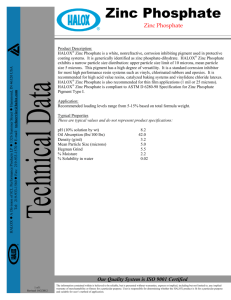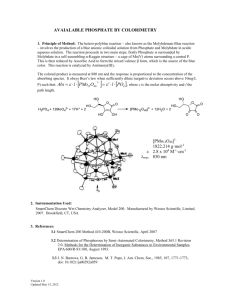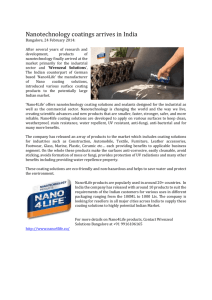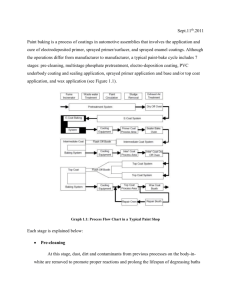The Study on Optimizing the Zinc Phosphate - 中正嶺學報
advertisement
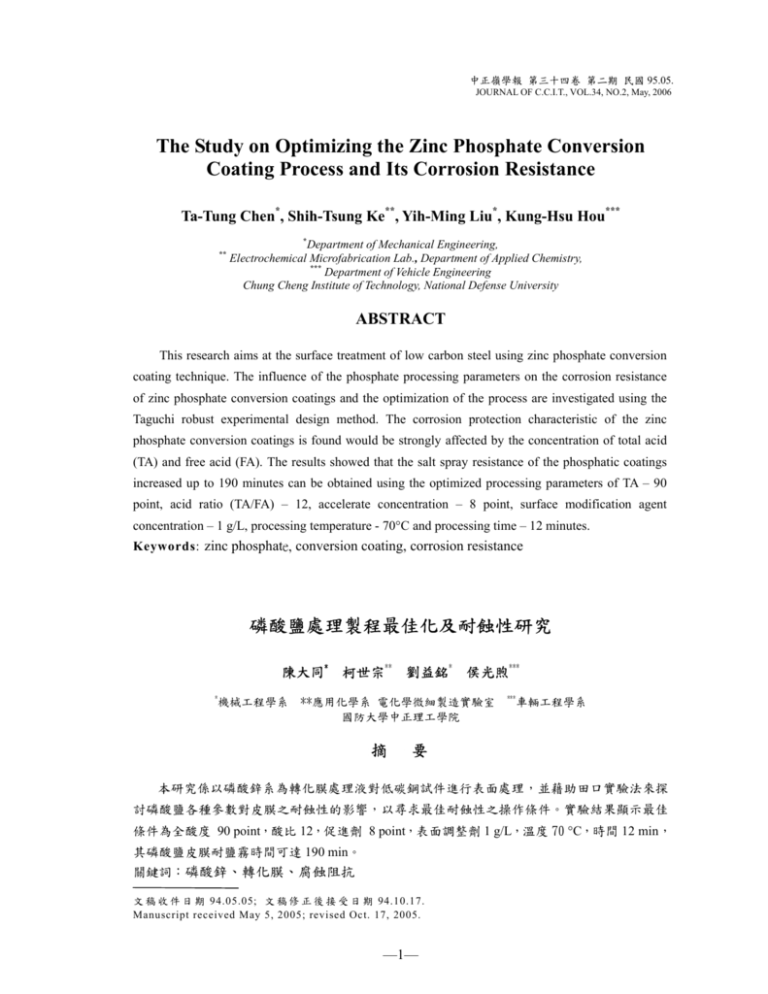
中正嶺學報 第三十四卷 第二期 民國 95.05. JOURNAL OF C.C.I.T., VOL.34, NO.2, May, 2006 The Study on Optimizing the Zinc Phosphate Conversion Coating Process and Its Corrosion Resistance Ta-Tung Chen*, Shih-Tsung Ke**, Yih-Ming Liu*, Kung-Hsu Hou*** * ** Department of Mechanical Engineering, Electrochemical Microfabrication Lab., Department of Applied Chemistry, *** Department of Vehicle Engineering Chung Cheng Institute of Technology, National Defense University ABSTRACT This research aims at the surface treatment of low carbon steel using zinc phosphate conversion coating technique. The influence of the phosphate processing parameters on the corrosion resistance of zinc phosphate conversion coatings and the optimization of the process are investigated using the Taguchi robust experimental design method. The corrosion protection characteristic of the zinc phosphate conversion coatings is found would be strongly affected by the concentration of total acid (TA) and free acid (FA). The results showed that the salt spray resistance of the phosphatic coatings increased up to 190 minutes can be obtained using the optimized processing parameters of TA – 90 point, acid ratio (TA/FA) – 12, accelerate concentration – 8 point, surface modification agent concentration – 1 g/L, processing temperature - 70°C and processing time – 12 minutes. Keywords: zinc phosphate, conversion coating, corrosion resistance 磷酸鹽處理製程最佳化及耐蝕性研究 陳大同* 柯世宗** 劉益銘* 侯光煦*** * 機械工程學系 **應用化學系 電化學微細製造實驗室 國防大學中正理工學院 摘 *** 車輛工程學系 要 本研究係以磷酸鋅系為轉化膜處理液對低碳鋼試件進行表面處理,並藉助田口實驗法來探 討磷酸鹽各種參數對皮膜之耐蝕性的影響,以尋求最佳耐蝕性之操作條件。實驗結果顯示最佳 條件為全酸度 90 point,酸比 12,促進劑 8 point,表面調整劑 1 g/L,溫度 70 °C,時間 12 min, 其磷酸鹽皮膜耐鹽霧時間可達 190 min。 關鍵詞:磷酸鋅、轉化膜、腐蝕阻抗 文 稿 收 件 日 期 94.05.05; 文 稿 修 正 後 接 受 日 期 94.10.17. Manuscript received May 5, 2005; revised Oct. 17, 2005. —1— 陳大同等 磷酸鹽處理製程最佳化及耐蝕性研究 I. INTRODUCTION The phosphate conversion coating technique is widely applied for the surface pretreatment of both ferrous and non-ferrous metals [1]. The purposes of this process are mainly served as the metal surface prime coating for the corrosion protection, lubrication, abrasion resistance, insulation and decoration applications. As a result of its low processing cost, simple operation procedures and good performance on surface protection, the phosphate conversion coating plays a significant role in various industries such as automobile, manufacture and tool fabrication. The surface protection performance of the metal after the phosphating process is improved without degrading its intrinsically promising physical and mechanical properties such as strength, hardness, elasticity, magnetism and elongation due to the formation of the uniform and dense phosphate conversion film on the surface. Zinc, manganese and iron phosphate conversion coatings are the most widely used phosphating processes. Zinc phosphate coating is commonly used for the purposes as the primer before applying paint, electrical insulation coating or other organic pigments. Manganese phosphate coating is mainly applied for the decoration and improvement of the wear resistance. Basically, these (zinc, manganese and iron) phosphate conversion coatings have good corrosion resistance and superior adhesion with the metal substrate [2-4]. Weng et al. investigated the corrosion protection characteristics of zinc and manganese phosphate coatings [5]. The results showed that the insulation capability of zinc phosphate film is better than that of manganese phosphate film, however, the zinc phosphate film was shown to have higher porosity than that of manganese phosphate film. It was found that the failure of zinc phosphate coating was primarily due to the chemical dissolution process, which would be speeded-up by the electrochemical corrosion of the metal substrate. The protection performance of zinc phosphate was considered to be dependent upon its barrier capability according to the results of Weng’s study [6]. Because the zinc phosphate coating was found to be able to be formed in short times with chemically stable and fine-crystallized film structures [7-10], which was quite suitable to be applied as the primer for the purpose rust-proofing of the surface of steel substrate [11]. The phosphate conversion coating is theoretically a complex chemical reaction process [12-14]. The process for the formation of the phosphate coating is thought to be dominated by two essential factors – film growth extent and film growth speed, which are related to the thermodynamics of chemical reactions and reaction kinetics. Basically, the process for forming the phosphate coating can be divided into four steps – ionization, hydrolysis, oxidation and crystallization, which can be derived according to the analysis results of the formulation of the —2— 中正嶺學報 第三十四卷 第一期 民國 94.11. JOURNAL OF C.C.I.T., VOL.34, NO.1, NOV., 2005 phosphating bath and the chemical composition of the phosphating conversion film. According to the above statement, it is indicated that the microstructure of the phosphate conversion coating has great influence on its corrosion protection properties and the adhesion ability to the subsequent painting. Therefore, the objectives of this study are to develop the optimum phosphate conversion coating parameters, such as total acid (TA) concentration, free acid (FA) concentration, acid ratio, accelerator concentration, surface modification agent concentration, temperature and time of the processing bath and investigate the effect of film microstructure on the phosphate conversion coating’s corrosion protection characteristics using Taguchi robust experimental designed method (three levels of experimental parameters shown in Table 1). Table 1. Three levels of the Taguchi robust experimental designed factors were involved during this study of investigating the corrosion protection capability of phosphate conversion coating. The configuration of the materials used for preparing zinc phosphate conversion coating bath solution is summarized in Table 2. Table 2. The configuration of materials was used to preparing zinc phosphate conversion coating bath. Surface modification agent: TiOSO4.2H2O Zinc phosphate: Zn3(PO4)2.2H2O Accelerator: Pb5(PO4)3Cl Indicator: phenolphthalein, bromophenol blue Titrant:0.1N NaOH Acid ratio modification agent: Na2CO3, HNO3 or H3PO4 2.2 Zinc Phosphate Conversion Coating Process The zinc phosphate conversion coating process for surface treating low carbon steel was (i) Alkaline degreasing and acid cleaning: Factors Total acid concentration (point) Acid ratio Accelerator concentration (point) Surface modification agent 0 concentration (g/L) Processing temperature (℃) 50 Processing time (mins) 6 Phosphate mainly conducted as the following steps: Level 1 30 4 4 2.1 Configuration of Zinc Conversion Coating Bath 2 45 12 6 3 60 20 8 The surface of the low carbon steel was 1 2 phosphate or silicate) aqueous solution 70 12 90 18 before degreased to remove the oil or soil deposits in alkaline the (for zinc example, phosphate carbonate, conversion coating process. The acid cleaning process was followed to remove the rust using 15-25 II. EXPERIMENTAL PROCEDURES % hydrochloride acid or 15-20 % sulphuric acid at 45-55°C. —3— 陳大同等 磷酸鹽處理製程最佳化及耐蝕性研究 quantity of the volume of the titrant. (ii) Water rinsing: The sample was water-rinsed the (ii) Free acid concentration: The zinc phosphate concentration of the pollutants induced conversion coating bath was also prepared by during the degreasing and acid cleaning diluting processes in order to increase the lifetime of solution of 10ml with the addition of 2-3 the phosphate coating bath. drops of the indicator – bromophenol blue at room temperature to reduce the concentrated phosphating (iii) Surface modification: The metallic surface and the titrant of 0.1N NaOH under stirring was modified by immersing in the 0.2-2 % to give the free acid concentration with 1-15 titanate aqueous solution under stirring. This points, which is considered to be equal to the process is aiming to reduce the time for quantity of the volume of the titrant. forming the phosphate conversion coating (iii) Accelerator concentration: The concentration with fine-grained structures and improve the of the accelerator was calculated as the film’s corrosion resistance. volume of the gas being diffused out of the (iv) Phosphate conversion coating: The grey solution during the preparation process by the phosphate conversion coating was formed on addition of concentrated phosphating solution the surface of the low carbon steel by the with 2-3g of sulfamic acid. immersion of the samples in the aqueous (iv) The alteration of the free acid concentration: solution of phosphate and nitrate at the The concentration of the free acid has to be temperature of 50-90°C for 6-18 minutes modified by adding acid ratio modification with the addition of the accelerator of 0.5-3 agent, g. concentration while altering the involved total acid during the phosphating coating process, in order to (v) Drying: The sample was then rinsed in water ensure and dried at the temperature of 120-180°C. a better quality of produced phosphating conversion film. The addition of 2.3 Titration Processes Were Involved During The Preparation of The Zinc Phosphate Conversion Coating Solution 0.43 g/L of Na2CO3 is needed for reducing 1 point of free acid concentration. On the contrary, the addition of 0.23 g/L of H3PO4 or 0.16 g/L of HNO3 is needed for increasing 1 point of free acid concentration. (i) Total acid concentration: The zinc phosphate (v) Acid ratio: The dependence of the ratio of conversion coating bath was prepared by total acid to free acid, altered in the ranges of diluting phosphating 5-20, on the phosphate conversion coating solution of 10ml with the addition of 3-5 processing parameters was investigated in drops of the indicator – phenolphthalein and this study. the concentrated Here, the point is a droplet liquid of the the titrant of 0.1N NaOH under stirring to give the total acid concentration with 25-65 titrant - 0.1N NaOH, a point is about 0.35 ml. points, which is considered to be equal to the —4— 中正嶺學報 第三十四卷 第一期 民國 94.11. JOURNAL OF C.C.I.T., VOL.34, NO.1, NOV., 2005 Table 3. Taguchi robust experimental designed was related to phosphate conversion coating parameters. 1 2 3 4 5 6 7 8 9 10 11 12 13 14 15 16 17 18 Total Acid Accelerator Surface modification Processing Processing Salt spray acid ration concentration agent concentration temperature time test time (point) (point) (g/L) (mins) (mins) (℃) 30 4 4 0 50 6 8 30 12 6 1 70 12 120 30 20 8 2 90 18 20 45 4 4 1 70 12 26 45 12 6 2 90 6 23 45 20 8 0 50 12 95 60 4 6 0 90 12 102 60 12 8 1 50 18 186 60 20 4 2 70 6 179 30 4 8 2 70 12 15 30 12 4 0 90 18 30 30 20 6 1 50 6 68 45 4 6 2 50 18 12 45 12 8 0 70 6 168 45 20 4 1 90 12 52 60 4 8 1 90 6 60 60 12 4 2 50 12 110 60 20 6 0 70 18 28 S/N ratio No. Total acid Acid ratio Accelerator concentration Surface modification agent concentration Processing temperature Processing time Fig. 1. The S/N response curve of the CRPC coatings were tested by salt spray method. —5— 陳大同等 磷酸鹽處理製程最佳化及耐蝕性研究 2.4 Salt Spray Test was summarized and drawn with reported data of Table 3. It is noted that the total acid and acid The corrosion resistance of zinc phosphating ratio are the primarily influenced processing coating on low carbon steel samples were parameters affecting the CRPC coating. The investigated by conducting the salt spray test, other based on the ASTM B-117 standard, with the secondarily influential are concluded as the Elite Salt Spray Tester using 5 wt % of processing time, concentration of the surface neutralized modification agent, processing temperature and salt solution (NSS) at the temperature of 35 ± 1°C. When the red rust considered to be the concentration of the accelerator. occur on the sample, the salt spray test will stop and record the test time. parameters In order to have a clear understanding of the influence of phosphating operation parameters on the salt spray resistance capability of 2.5 AC Impedance Analysis phosphate conversion coated samples, the relation The AC impedance behavior of zinc between the average salt spray resistance time and the three levels processing phosphate conversion coating was also analyzed parameters to evaluate the film’s corrosion protection experimental results shown in Table 3. The performance analytic results are shown in Figures 2-7. using the electrochemical impedance spectroscopy (EIS) technique in the 5 wt % NaCl test solution. is analyzed based on the The effect of total acid concentration on the corrosion protection characteristics of the phosphate conversion coating is shown in Figure III. RESULTS AND DISCUSSION 2. The CRPC coating displayed to be increased with the increasing of the total acid The effect of processing parameters on the concentration. Therefore, it is better to control salt spray test results of zinc phosphate the total acid in the upper limit of the required conversion coated samples were analyzed by ranges of the concentration involved during the using the Taguchi robust experimental design phosphate process. Because the higher total acid method, which is shown in Table 3. The right concentration column shows the time for the red rust to be phosphoric occurred, ranged from 8 to 186 minutes, phosphating coating process, which will lead to representing the ability of resisting the salt the formation of fine-grained film structure. results reaction in faster involved speed during of the spraying. It means that the “corrosion resistance Figure 3 shows the influence of the acid ratio of the phosphate conversion (CRPC)” coatings on the corrosion resistance capability of the were strongly dependent upon the phosphating phosphating coating. With the acid ratio to be processing parameters. Figure 1 displays the increased, the CRPC performance is found to be signal to noise (S/N) ratio response curve, which improved due to the faster phosphoric reaction —6— 中正嶺學報 第三十四卷 第一期 民國 94.11. JOURNAL OF C.C.I.T., VOL.34, NO.1, NOV., 2005 resulting in thin phosphate film with fine The effect of adding free acid, which microstructure, however, it leads to the difficulty dominates the reaction of the dissolution of iron in forming the film and the degradation of the normally occurred during the phosphating coating’s corrosion protection ability while using process resulting in more nuclei with the too high acid ratio of the phosphating solution. formation of fine-grain-structured coating, on As the acid ratio used is too low, the phosphate the corrosion resistance of phosphate coating is coating with coarse-grained microstructure is considered to be relevant to the total acid produced due to the slow phosphoric reaction concentration and acid ratio of the used occurred during the coating process. Therefore, phosphating bath solution. However, it is in order to achieve better CRPC coatings, the observed acid ratio of the phosphating solution needed to concentration, the faster dissolution of iron be optimized. occurred leading to the formation of lots of that the higher the free acid hydrogen gas, which makes it difficult for the 120 nuclei to be formed due to the production of 110 non-saturated phosphate in the interface between 100 the coating and the metal substrate. The time (min) 90 80 corrosion protective ability of the coatings is 70 degraded because of the formation of the 60 50 coarse-crystallized film structure with variety 40 porosities sparsely distributed on the film 30 30 35 40 45 50 55 60 surface. There are thin or no phosphate coatings Total acid (Point) Fig. 2. The related curve is “TA concentration” vs. the red rust happen timing of CRPC coating. noted to be formed while too low free acid concentration is involved during the phosphating process. The CRPC of coatings is shown (see Figure 120 4) less affected by the accelerator with the 110 concentration set from 4 to 6 point. However, it 100 is still required that the accelerator should be t (min) 90 80 controlled at higher concentration in order to 70 inhibit the formation of the hydrogen gas, 60 promote the anodic oxidation reaction occurred 50 40 30 on the work-piece surface during the coating 2 4 6 8 10 12 14 16 18 20 22 process and prevent from the occurrence of the Acid ratio (Point) Fig. 3. The related curve is the “acid ratio” vs. the red rust happen timing of CRPC coating. cathodic polarization process, resulting in the formation of fine crystallized phosphate conversion coating with improved corrosion —7— 陳大同等 磷酸鹽處理製程最佳化及耐蝕性研究 protection. t (min) It is shown in Figure 6 that the temperature 120 115 110 105 100 95 90 85 80 75 70 65 60 55 50 45 40 35 30 involved during the phosphating process should be carefully set at about 70°C in order for obtaining better CRPC coating. As the temperature is too high, it induced a very fast phosphoric reaction leading to the formation of coarse-grained coating with poor corrosion resistance. On the contrary, as the temperature is 4 5 6 7 too low, it was also found that the produced 8 Accelerator concentration (Point) phosphate coating was thin with poor resistance Fig. 4. The related curve is the “accelerator concentration” vs. the red rust happen timing of CRPC coating. to the corrosion environment due to the resulted slow phosphoric reaction involved during the phosphating process. As shown in Figure 5, in order to obtain 120 coatings with better corrosion protection, the 110 100 surface modification agent concentration should 90 t (min) be adequately controlled (not very high) at the concentration around 1g/L. The reason for 80 70 60 preventing using too high concentration of the 50 surface modification agent is probably related to 40 the possibility of resulting in the over-activated 30 50 60 70 80 90 o Processing temperature ( C) t (min) surface during the coating process. 120 115 110 105 100 95 90 85 80 75 70 65 60 55 50 45 40 35 30 Fig. 6. The related curve is the “processing temperature” vs. the red rust happen timeing of CRPC coating. Figure 7 shows the influence of the processing time on the resulted CRPC coatings, which indicates that the processing time and used during the phosphating process has better 0.0 0.5 1.0 1.5 to be controlled at around 12 minutes. Basically, 2.0 Surface modification agent concentration (g/L) the thickness of the conversion coating is Fig. 5. The related curve is the “surface modification agent concentration” vs. the red rust happen timing of CRPC coating. increased with the increasing processing time that leads to the longer phosphoric reaction process. However, as the selected processing —8— 中正嶺學報 第三十四卷 第一期 民國 94.11. JOURNAL OF C.C.I.T., VOL.34, NO.1, NOV., 2005 time is too long, the thickness of the coating is additive = 1 g/L, temperature of bath = found to stop being thickened due to reaching 70°C and processing time = 12 minutes. The the equilibrium state of the ‘crystallization ⇔ obtained surface morphology is shown in Figure 9, dissolution’ the which is finer and smoother than the surface phosphating process. The longer processing time morphology of the phosphlating coating obtained also causes the poor stability of the formed using the processing parameters of level 1 (see conversion coatings due to the over-etching by Figure 8). reaction involved during 2+ the free acid resulting in too many Fe ions. While the processing time used is too short, the quality of the phosphoric reaction becomes poor, which will produce the thin and non-uniform phosphate conversion coatings with poor t (min) corrosion protection. 120 115 110 105 100 95 90 85 80 75 70 65 60 55 50 45 40 35 30 Fig. 8. The surface morphology of the phosphlating coating obtained using the processing parameters of level 1. 6 8 10 12 14 16 18 Processing time (min) Fig. 7. The related curve is the “processing time” vs. the red rust timing of CRPC coating. Based on the results of the level analysis of the average maximum S/N ratio of various phosphating processing parameters, the best corrosion protective phosphate conversion coatings was obtained with no clear indication of rust formation observed after 190 minutes of salt spray test using the optimum parameters of TA = 90 point, acid ratio (TA/FA) = 12, accelerator additive = 8 point, surface modification agent Fig. 9. The surface morphology of the phosphlating coating obtained using the optimum processing parameters (TA – 90 point, acid ratio – 12 , accelerator concentration – 8 point, surface modification agent concentration - 1g/L, processing temperature - 70 ℃ , processing time – 12 mins). —9— 陳大同等 磷酸鹽處理製程最佳化及耐蝕性研究 optimum processing parameters. The results in evaluating the corrosion protection phosphate coating with optimum corrosion resistance that electrochemical is shown to have AC impedance (∼ 65kohm) impedance spectroscopy technique were shown higher than the one with inferior corrosion in the Nyquist diagrams (see Figures 10 and 11), resistance (obtained using the parameters of which are shown to have good correlation with level 1) having lower AC impedance of ∼ the experimental results by the salt spray test. To 20Kohm. conversion performance coatings of using the It is clearly indicated that the phosphate compare the Nyquist plots for the phosphate conversion coatings using the optimum IV. CONCLUSIONS processing parameters on the analysis results of the salt spray test (Figure 11) and the processing parameters of level 1 (Figure 10). Based on the experimental results using Taguchi robust experimental design method, it is noted that the total acid and acid ratio are the primarily influenced processing parameters affecting the corrosion resistance of the phosphating conversion coating. The other parameters considered to be the secondarily influential are concluded as the processing time, concentration of the surface modification agent, processing temperature and concentration of the accelerator. Fig. 10. The Nyquist diagram obtained for the phosphate conversion coating using the processing parameters of level 1. The parameters for obtaining optimum corrosion protective phosphate conversion coating with no clear indication of rust formation observed after 190 minutes of salt spray test are TA – 90 point, acid ratio (TA/FA) – 12, accelerator additive – 8 point, surface modification agent additive – 1 g/L, Fig. 11. The Nyquist diagram obtained for the phosphate conversion coating using the temperature of bath - 70°C and processing time – 12 minutes. It is noted that the phosphate conversion coating with the optimum corrosion resistance is shown to have higher AC impedance (∼ 65kohm) than the one with inferior corrosion resistance (obtained using the parameters of level 1) having lower AC —10— 中正嶺學報 第三十四卷 第一期 民國 94.11. JOURNAL OF C.C.I.T., VOL.34, NO.1, NOV., 2005 impedance ∼ 20Kohm. The results in testing the corrosion protection performance of the phosphate conversion coatings using electrochemical impedance spectroscopy technique were shown to have good correlation with the evaluation results by the salt spray test. [6] The ASM Committee on Phosphate Coating, “Metals Handbook,” American Society for Metals, 9th ed., Vol. 5, pp. 434, 1982. [7] Cape, T.W., “Metals Handbook,” American Society for Metals, 9th ed., Vol. 13, pp. 383, 1982. [8] Di Giampaolo, A.R., Puerta, M., Ruiz, H., and Olivares, J. L., “Thick Aluminosilicate REFERENCES Coatings on Carbon Steel via Sol-Gel,” Journal of Non-Crystalline Solids, Vol. [1] Narayanan, T.S.N.S., “Influence of Various Factors on Phosphatability - An Overview,” Metal Finishing, Vol. 94, No. 6, pp. 86-90, 147-48, pp. 467-473, 1992. [9] Kelly, and Velez, M., “Zinc Phosphate Interlayer for Sol-Gel-Derived Aluminosilicate Coating on AISI-1010 Carbon Steel,” Surface and [10] Scislowski, A., Carbon Mechanism and Effect of Polyacrylic Acid Steel Zinc-Phosphate-Painted Surface and Coatings as Substrates for Automotive Coatings,” Progress in Organic Coatings, Vol. 28, No. 1, pp. 59-76, 1996. [13] Vasovic, D.D., Stojakovic, D.R., and Zec, S.P., “Metal Phosphate Preparation Using Boron Zinc Phosphate-to-Polymer Adhesive Joints,” pp. 722-736, 1987. Steel,” Corrosion Mechanisms of Phosphated Zinc Layers on on The Improvement in Bond Durability of Journal of Materials Science, Vol. 22, No. 2, of the [12] Amirudin, A. and Thierry, D., “Corrosion [4] Sugama, T., Kukacka, L. E., Carciello, N., “Chemisorption of 1999. Vol. 122, No. 2-3, pp. 94-100, 1999. B., Metal Technology, Vol. 113, No. 1-2, pp. 36-43, Coatings,” Surface and Coatings Technology, J. “Phosphating,” “Evaluation Performance Dubois, A., and Oudin, J., “The Effects of Warren, S., [11] Guenbour, A., Benbachir, A., and Kacemi, [3] Lazzarotto, L., Maréchal, C., Dubar, L., and Fastener Finishing, Vol. 89, No. 4, pp. 29-30, 1991. 31-37, 1997. And Performance of Zinc Phosphate Stearate Of 4, pp. 15-19, 1988. Coatings Technology, Vol. 89, No. 1-2, pp. Processing Bath Parameters on The Quality “Principles Pretreatment,” Metal Finishing, Vol. 86, No. 1996. [2] Di Giampaolo, A.R., Medina, M., Reyes, R., R., Phosphate,” Materials Research Bulletin, Vol. 32, No. 6, pp. 779-784, 1997. [14] Kouisni, L., Azzi, M., Zertoubi, M., Dalard, [5] Weng, D., Jokiel, P., Uebleis, A., and Boehni, H., “Corrosion and Protection Characteristics of Zinc and Manganese Phosphate Coatings,” Surface and Coatings Technology, Vol. 88, No. 1-3, pp. 147-156, 1997. —11— F., and Maximovitch, S., “Phosphate Coatings on Magnesium Alloy AM60 Part 1: Study of the Formation and the Growth of Zinc Phosphate Films,” Surface and Coatings Technology, Vol. 185, No. 1, pp. 58-67, 2004.


